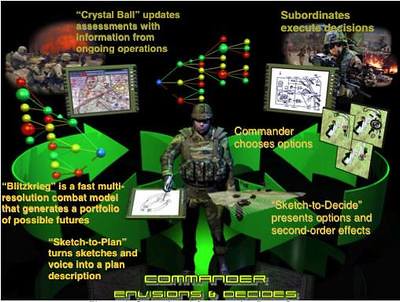Darpa Goes “Deep Green”
When it comes to battlefield planning and execution, a crystal ball would certainly make a field commander’s life a whole lot easier.
That’s exactly what DARPA — the research and development arm of the Department of Defense — hopes to create (sort of) with the "Deep Green" program.

DARPA describes the requirements for Deep Green in its call for ideas (PDF here):
Deep Green will build a battle command decision support system that interleaves anticipatory planning with adaptive execution. Deep Green must be capable of addressing the full spectrum of joint and combined arms capabilities available to the modular brigade commander, drastically increasing the option and future space. This will allow the commander to think ahead, identify when a plan is going awry, and help develop alternatives “ahead of real time.” The commander (and his support staff) is involved in essentially two major asynchronous functions: generating options and making decisions. The goal of this program is to create a commander-driven system to assist the commander and his support staff in generating options or Courses of Action (COAs).
Wired explains further:
Deep Green has a half-dozen different interlocking components, including a "Sketch to Plan" program that reads a commander’s doodles, listens to his words, and then "accurately induces" a plan, "fill[ing] in missing details." That allows an officer "to specify an option at a coarse level, then move on to the next cognitive task." A related program, "Sketch to Decide" allows a commander to "see the future" by producing a "comic strip" to represent his possible options in a given situation. That may "sound exotic," the Agency notes. But "since the 1970s (and perhaps earlier), there have been novels and game books in which the reader is asked to make a decision and then is directed to a different page or paragraph, depending on the choice made."
To make these warzone versions of choose-your-own-adventure novels, Darpa proposes two pieces of software. "Blitzkrieg" will quickly model sets of alternatives, while "Crystal Ball" will take information currently coming into a headquarters to figure out which scenarios are the most likely to happen, and which plans are likely to work best. Crystal Ball will use this estimate to nominate to the commander futures at which he/she should focus some planning effort to build additional options/branches. Crystal Ball will identify the trajectory of the operation in time to allow the commander to generate options before they are needed.
So why the name Deep Green? The Register snarkily explains:
The colour presumably alludes to the fact that – at least to start with – the robocommand package is intended to help US Army bird colonels handle their "modular brigade" battle groups. If the project were a British Army one, the project might be known as "Deep Brown" (Or there again, maybe not). As Deep Blue is already taken, future versions for the other US services will presumably be known as Deep Periwinkle (air force) and Actually Deep Blue (navy).
The R&D timeline is slated for just three short years, though that estimate is made without the benefit of a crystal ball, we presume.